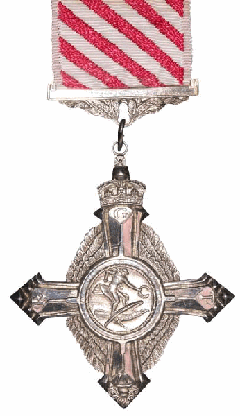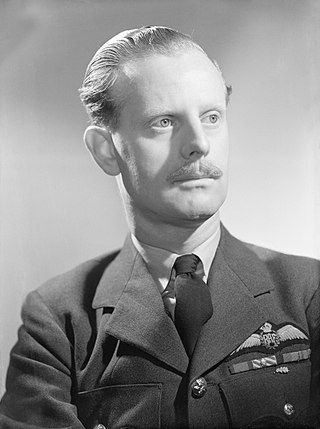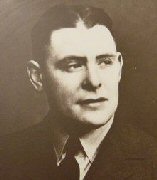
The Distinguished Flying Cross (DFC) is the third-level military decoration awarded to officers, and since 1993 to other ranks, of the United Kingdom's Royal Air Force and other services, and formerly to officers of other Commonwealth countries, for "an act or acts of valour, courage or devotion to duty whilst flying in active operations against the enemy".

Air Commodore Sir Hughie Idwal Edwards, was a senior officer in the Royal Air Force, Governor of Western Australia, and an Australian recipient of the Victoria Cross, the highest decoration for gallantry "in the face of the enemy" that can be awarded to members of the British and Commonwealth armed forces. Serving as a bomber pilot in the Royal Air Force (RAF), Edwards was decorated with the Victoria Cross in 1941 for his efforts in leading a bombing raid against the port of Bremen, one of the most heavily defended towns in Germany. He became the most highly decorated Australian serviceman of the Second World War.

The Air Force Cross (AFC) is a military decoration awarded to officers, and since 1993 other ranks, of the British Armed Forces, and formerly also to officers of the other Commonwealth countries. It is granted for "an act or acts of exemplary gallantry while flying, though not in active operations against the enemy". A bar is added to the ribbon for holders who are awarded a further AFC.

Christopher Frederick Currant,, nicknamed "Bunny", was a Royal Air Force fighter pilot and flying ace of the Second World War.

Air Chief Marshal Sir James Donald Innes Hardman,, known as Donald Hardman, was a senior Royal Air Force commander. He began his flying career as a fighter pilot in World War I, achieving nine victories to become an ace. During World War II, Hardman held senior staff and operational posts. He was Chief of the Air Staff (CAS) of the Royal Australian Air Force (RAAF) from 1952 to 1954, after which he served as a member of the British Air Council until retiring in 1958.

Air Marshal Sir John Rowlands, was a senior Royal Air Force commander and a recipient of the George Cross for his work in bomb disposal during the Second World War. He later worked in the development of Britain's nuclear weapons programme.

Wing Commander Howard Peter "Cowboy" Blatchford, DFC was a flying ace, who achieved the first Canadian victory in World War II.
James Blackburn, was a Royal Air Force officer who completed a record five tours of operations during the Second World War.

Raymond Brown Hesselyn, was a New Zealand fighter pilot and flying ace of the Second World War, credited with the destruction of at least 18 enemy aircraft while flying with the Royal Air Force (RAF) over Europe and the Mediterranean.

Group Captain Desmond James Scott, was a New Zealand fighter pilot and flying ace of the Second World War. He was credited with the destruction of at least five enemy aircraft.
Air Vice-Marshal Ekanayake Edward Rohan Ameresekere, was a senior officer in the Royal Ceylon Air Force. He served as the third Commander of the Royal Ceylon Air Force. He previously served he had served as a navigator in the Royal Air Force during World War II, before qualifying as a pilot in the newly formed Royal Ceylon Air Force.

Donald Ernest Kingaby, was a Royal Air Force (RAF) aviator and flying ace of the Second World War. He was the only person to be awarded the Distinguished Flying Medal three times.
Henry Winslow Woollett, was a British flying ace and the highest scoring British balloon busting ace credited with 35 aerial victories, including eleven balloons, during the First World War. He continued to serve in the Royal Air Force until the 1930s.

Air Commodore Peter Malam "Pete" Brothers, was a Royal Air Force fighter pilot and flying ace of World War II. Brothers was credited with 16 aerial victories, 10 of which he achieved during the Battle of Britain.

Air Vice Marshal William Ernest Staton, was a British airman who began his career as a First World War flying ace credited with 26 victories. He was transferred to the Royal Air Force (RAF) on its creation in 1918 and remained in the RAF during the inter-war years. During the Second World War he served in England and pioneered the bombing technique of using pathfinders to mark targets. He then served in the Far East before becoming a prisoner of war to the Japanese. After the war he returned to Great Britain and the RAF where he reached air rank and twice captained the British Olympic Shooting Team.

Air Commodore Raymond James Brownell, was a senior officer in the Royal Australian Air Force (RAAF) and a First World War flying ace. Born in Hobart, Tasmania, Brownell was working as a clerk with a firm of accountants when he enlisted in the Australian Imperial Force on the outbreak of the First World War. He served during the Gallipoli Campaign before transferring to the Western Front. Awarded the Military Medal for his actions during the Battle of Pozières, he was accepted for a transfer to the Royal Flying Corps in 1917. After flight training in the United Kingdom, Brownell was commissioned as a second lieutenant and posted for operational service over the Western Front in September 1917. Moving with his squadron to Italy, he was awarded the Military Cross and credited with shooting down 12 aircraft by war's end. Taking his discharge in 1919, Brownell returned to Australia.

Air Commodore John William Boldero Grigson was a highly decorated British pilot who served in the Royal Naval Air Service and Royal Air Force in World War I, continuing his service and serving in World War II until his death in an air crash in 1943.
Group Captain Charles Henry Chapman Woollven was a British professional soldier who began his military career during World War I. He became a flying ace credited with five aerial victories while piloting a two-seater FE.2b into combat. Postwar, he remained in the Royal Air Force, rising through the officer's ranks while holding increasingly more important posts during the 1920s and 1930s. By 1938, on the eve of World War II, he was a wing commander. Promoted to the rank of group captain by war's end, he retired in 1947.
Dudley Lloyd-Evans, was a Welsh-born soldier, airman and flying ace. After being decorated for his infantry service during the First World War, he transferred to aviation, was credited with eight official aerial victories, and again won military honours for his valour. He remained in the Royal Air Force until the end of the Second World War.

Group Captain Francis Victor Beamish, was a Royal Air Force fighter pilot and flying ace of the Second World War. After flying during the Battle of Britain he continued to lead fighter operations until he was killed in action in 1942.













